

|
| SCHWEIZ / SUISSE / SVIZZERA / SVIZRA | SWITZERLAND |
| Sankt 3 / Saint Gall / San Gallo / Son Gagl |
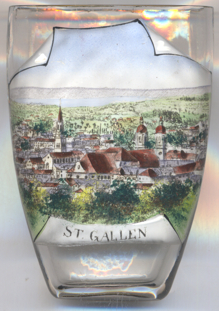 Sankt Gallen is named after the Celtic missionary Gallus who built
his hermitage here in AD 612. Saint Othmar (d. 759) was abbot of the monastery in the 8th century.
The Benedictine abbey of St. Gallen
became an important centre of learning and culture in the 9th and 10th century.
The library of medieval manuscripts is world-famous.
The first mentioning of St. Gallen in a document as a market town is found in 1170.
During the 14th and 15th century the linen industry and trade flourish and
became an important oeconomic factor for the town.
During the Appenzell Wars of Independence the citizens form an alliance with
the peasants against the abbey. The town joined the Swiss Confederation in 1454.
The second foundation of the abbey in 1468 marked
the beginning of a second 'golden age' of the abbey.
However, in 1529 the Reformation is introduced in St. Gallen by
Joachim von Watt, called Vadian.
St. Gallen became the capital of the newly founded canton of the
same name in 1803. The monastery of St. Gallen was listed as a UNESCO World Heritage site in 1983
(see also list of other UNESCO heritage sites).
Sankt Gallen is named after the Celtic missionary Gallus who built
his hermitage here in AD 612. Saint Othmar (d. 759) was abbot of the monastery in the 8th century.
The Benedictine abbey of St. Gallen
became an important centre of learning and culture in the 9th and 10th century.
The library of medieval manuscripts is world-famous.
The first mentioning of St. Gallen in a document as a market town is found in 1170.
During the 14th and 15th century the linen industry and trade flourish and
became an important oeconomic factor for the town.
During the Appenzell Wars of Independence the citizens form an alliance with
the peasants against the abbey. The town joined the Swiss Confederation in 1454.
The second foundation of the abbey in 1468 marked
the beginning of a second 'golden age' of the abbey.
However, in 1529 the Reformation is introduced in St. Gallen by
Joachim von Watt, called Vadian.
St. Gallen became the capital of the newly founded canton of the
same name in 1803. The monastery of St. Gallen was listed as a UNESCO World Heritage site in 1983
(see also list of other UNESCO heritage sites).
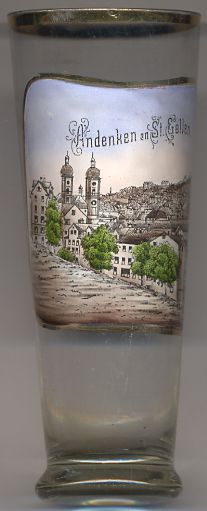
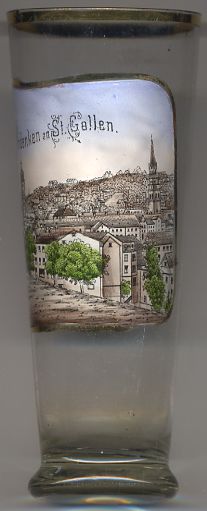
In 1992 the city of St. Gallen was awarded the Wakker Prize of the Swiss Heritage Society for the development and
preservation of its architectural heritage.
Other cities that have been awarded this prize and which are depicted on glasses of this collection are:
Altdorf (2007),
Baden (2020),
Basel (1996),
Bern (1997),
Biel/Bienne (2004),
Genève (2000),
La Chaux-de-Fonds (2011),
Lausanne West (Bussigny-près-Lausanne, Chavannes-près-Renens, Crissier, Ecublens, Lausanne, Prilly, Renens, Saint-Sulpice, Villars-Sainte-Croix) (2011),
Montreux (1990),
Solothurn (1980),
Stein am Rhein (1972),
Wil (1984),
Winterthur (1989).
The  monastery church Sankt Gallus und Otmar
[left, no. 2694: left; and right: no. 3457: right]
was built in 1755–1766. The monastery was dissolved in 1805.
Since 1824 the church is the cathedral church of the Catholic diocese of St. Gallen.
monastery church Sankt Gallus und Otmar
[left, no. 2694: left; and right: no. 3457: right]
was built in 1755–1766. The monastery was dissolved in 1805.
Since 1824 the church is the cathedral church of the Catholic diocese of St. Gallen.
The  Reformed church Sankt Laurenzen
[left, no. 2694: right; and right: no. 3457: left]
goes back to a church that presumbly was built in the mid-12th century.
The present (fifth) church was built in 1851–1854 in Gothic revival style.
Reformed church Sankt Laurenzen
[left, no. 2694: right; and right: no. 3457: left]
goes back to a church that presumbly was built in the mid-12th century.
The present (fifth) church was built in 1851–1854 in Gothic revival style.
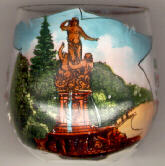
The  Broderbrunnen (Broder fountain)
was erected in 1896 to commemorate the improvement of the water supply of
St. Gallen by water brought into the town from Lake Constance in 1895.
The fountain is named after judge Hans Broder, whose legacy made it possible
to pay for the fountain. The figures of the fountain were made by galvanic
copper metallization of plaster figures, a technique which was popular at
that time because it was cheaper than bronze casting. In 1998, the figures
were removed and are being replaced by a bronze casting copy. The originals
are to be exhibited in the art museum of St. Gallen.
Broderbrunnen (Broder fountain)
was erected in 1896 to commemorate the improvement of the water supply of
St. Gallen by water brought into the town from Lake Constance in 1895.
The fountain is named after judge Hans Broder, whose legacy made it possible
to pay for the fountain. The figures of the fountain were made by galvanic
copper metallization of plaster figures, a technique which was popular at
that time because it was cheaper than bronze casting. In 1998, the figures
were removed and are being replaced by a bronze casting copy. The originals
are to be exhibited in the art museum of St. Gallen.
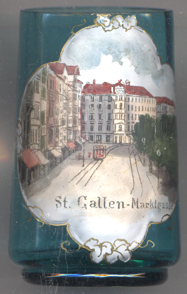
The  Hotel Hecht was already mentioned in 1624. The present building dates from
1860–1920. The movie and vaudeville theatre "Scala" opened in in the building in 1930,
the cinema "Hecht" opened in 1953; both cinemas were combined in 1985. The hotel closed in 1987/88 and therafter
successively was home to several different restaurants and for several years the hotel remained empty.
The complex was renovated in 1993/1995.
Hotel Hecht was already mentioned in 1624. The present building dates from
1860–1920. The movie and vaudeville theatre "Scala" opened in in the building in 1930,
the cinema "Hecht" opened in 1953; both cinemas were combined in 1985. The hotel closed in 1987/88 and therafter
successively was home to several different restaurants and for several years the hotel remained empty.
The complex was renovated in 1993/1995.
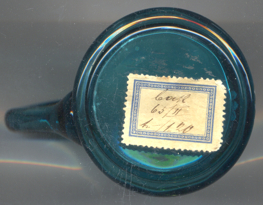
Another glass in this collection shows a view of
Sankt Gallen in Styria, Austria.
[http://www.memoria.sg/aufnahmen/bohl-1, www.e-periodica.ch/cntmng?pid=hoc-001:1995:8::1020]
![[scale]](lineal.jpg)